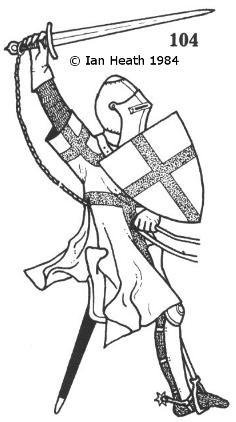
Amazon Audible Gift Memberships
GERMAN KNIGHT, ERZBISCHOF VON TRIER 1312
An extract from Armies of the Middle Ages, Volume 2by Ian Heath



104. GERMAN KNIGHT, ERZBISCHOF VON TRIER 1312
The ensuing sequence of 9 figures follows the general evolution of armour in Germany during the 14th and 15th centuries, beginning with this early-14th century figure from illustrations in the codex of Baldwin von Trier, depicting events during Emperor Henry VII’s Romzug of 1312. The short-sleeved surcoat doubtless conceals the usual layered body-armour characteristic of the 14th century, comprised of a quilted gambeson, a mail hauberk and a coat-of-plates, but the only plate armour visible is his greaves and the small poleyns affixed to his mail chausses. His gauntlets are of leather, though bag mittens also continued to be worn (as, for example, in the ‘Manessa Codex’ of similar date). Two other points to note are his heaume with its movable visor, a feature which appeared at the very end of the 13th century, and his rowel spurs. The latter first appear in a Spanish ms. of the 9th century but only begin to occur regularly during the late-13th century, usually having 6-12 points.
For fuller details of the development of individual elements of the armours described both here and below, see volume 1.
[Based on a battle in 'Codex Balduini Trevirensis', Germany, 1341. Landeshauptarchiv Koblenz]